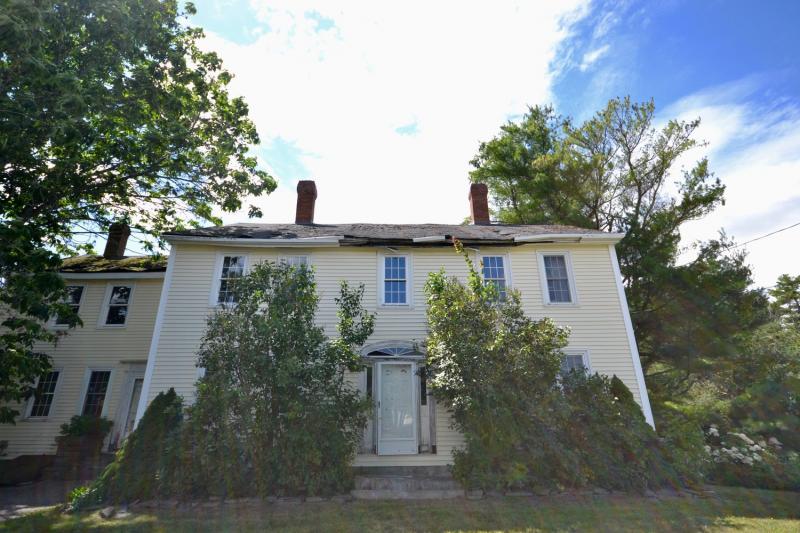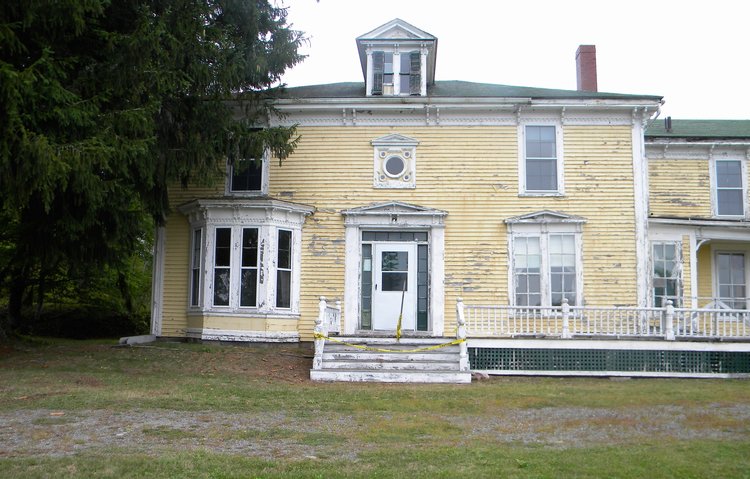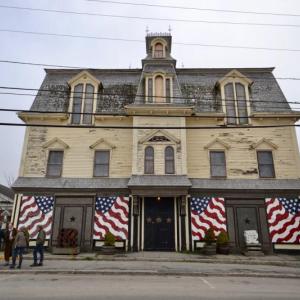Vinalhaven ‘Star of Hope’ building on 2018 Maine’s Most Endangered Historic Places list
The Yarmouth-based nonprofit Maine Preservation released its 20th list of ‘Most Endangered Historic Places in Maine’ Oct. 30 following its annual gala. On it are a Vinalhaven building, the Frances Perkins Homestead, Newcastle; the working waterfront in Boothbay Harbor; historic Maine dams, statewide; McGlashan-Nickerson House, Calais; Cushman Tavern, Lisbon/Sabattus; and the Clough & Pillsbury Building, Rumford.
Maine Preservation is the statewide, nonprofit, membership organization that promotes and preserves historic places, buildings, downtowns and neighborhoods, strengthening the cultural and economic vitality of Maine communities.
The Most Endangered Historic Places List began in 1996 for the purpose of identifying and raising public awareness of preserving endangered and threatened historic properties and materials. Since that time 158 places have been included on the list of which 55 have been saved and 44 are in motion. Only 18 have been lost.
"Maine’s 2019 Most Endangered Historic Places List illustrates the diverse historic buildings, structures and issues that are critical to the future of communities across our state,” said Greg Paxton, executive director of Maine Preservation, in a news release. “Preservation of key structures is a catalyst for community revitalization, economic development and continued quality of life for the citizens of Maine’s towns and cities. Historic preservation bolstered the state’s economy throughout the recent downturn and has continued to be a key catalyst for community vitality in the current economy. To consolidate these gains, we must continue to wisely manage our downtowns, in town neighborhoods and rural historic assets to increase our tax base and provide a firm foundation for future prosperity and quality of life, as this list illustrates.”
What follows is the summary of the properties on the list, as written by Maine Preservation.
Star of Hope, Vinalhaven
The Star of Hope Lodge, founded in 1874 as the local Independent Order of Odd Fellows, met for generations above the M.K. Kiff store.
As the order, members purchased the store and the adjacent building, joining the two and adding the now famous mansard-roofed third floor in 1885. The clapboarded building continued to house retail on the first floor while the second and third floors functioned as meeting space and a lodge hall for the IOOF.
Standing proudly on the north side of Main Street it is still one of the largest buildings along the waterfront and a reminder of the prosperity of Vinalhaven’s granite industry. The IOOF used the building until the 1930s, after which a drugstore occupied only the first floor.
In 1969, the Order sold the building to noted photographer Eliot Elisofon, and the pop artist Robert Indiana subsequently rented the building.
In 1977, after Elisofon’s death, Indiana purchased the property, completing a full restoration in 1981.
It was listed in the National Register of Historic Places the following year and Indiana used it as his home and studio until his death in 2018.
Today, the Star of Hope towers over Main Street, but windows are boarded up, there is a tarp over a hole in the roof, and the exterior clapboards and sheathing have deteriorated significantly.
Robert Indiana became more reclusive as he aged and, despite his affection for his home of four decades, it fell into a state of decay. His estate is currently embroiled in a federal lawsuit filed by Morgan Art Foundation Limited that alleges individuals close to Indiana have sold his works without proper compensation, forged some artwork as well as isolating and exploiting him.
Indiana’s will calls for the Star of Hope to be turned into a museum of his artwork, as well as a public space for lectures and classes. As the current legal battle drags on the building continues to deteriorate. All parties involved in the administration of Indiana’s estate must ensure that pending legal action does not cause further dangerous deterioration of the building.
This building is the centerpiece of Vinalhaven’s Main Street and its restoration is key to the economic health of the downtown and to the legacy of Robert Indiana. Immediate repair of the roof and windows, and the stabilization of any structural deficiencies will allow the building to be ”mothballed” until the Indiana estate is able to move forward with complete restoration. If nothing is done in the short term, significant exterior and interior features of the Star of Hope will be lost.
Frances Perkins Homestead, Newcastle
Near the banks of the Damariscotta River in Newcastle sits a modest two-story Greek Revival saltwater farm. The 1837 brick house and connected barn are surrounded by verdant fields, wooded groves and stone walls on property that has been home to the Perkins family for over 250 years.
Frances Perkins, the nation’s first female cabinet officer, summered here from 1880-1965, and devoted her life to public service, most famously as Secretary of Labor from 1933-1945. Perkins accomplished much in this post and is credited as the architect of key provisions of the New Deal, including many programs that helped bring the nation out of the Great Depression. She was instrumental in the establishment of Social Security, the minimum wage, standardizing the 40-hour work week, banning child labor, and developing the nation’s unemployment insurance and worker compensation systems.
Throughout her life she found respite at her family’s farm. The property is currently owned by her grandson, who occasionally opens it for tours led by the nonprofit Frances Perkins Center. It was designated a National Historic Landmark in 2014.
While the principal structures of the homestead have survived nobly over 180 years, harsh Maine winters have taken their toll.
A recently completed conditions assessment identified deteriorated roofs, windows, doors and exterior brick walls as well as failing posts, floor framing and roof beams, and antiquated mechanical systems. These issues are threatening both the buildings and contents, and significant repairs are required to protect the building and allow it to host visitors as a public educational site. Currently the Frances Perkins Center has a right of first refusal to purchase the property but must raise funds to cover the cost of rehabilitation in addition to the purchase price, before this agreement expires in November 2019.
Help is needed for the Frances Perkins Center Board to meet its ambitious $5.5 million capital campaign goal of acquiring the property before it’s too late. Preserving this homestead, Frances Perkins’ “place of the heart,” is a once-in-a- lifetime opportunity. This National Historic Landmark must be rehabilitated to ensure future generations can be inspired by Frances Perkins’ legacy.
Working Waterfront, Boothbay Harbor
Maine’s 3,500-mile shoreline — 5,300 miles, including islands — is the longest of any state on the East Coast and has helped define the character of the Pine Tree State.
Sadly, the latest assessment suggests that only 20 miles of mainland and island shoreline are still considered working waterfront used to support commercial fishing. Maine’s commercial fishing industry brought in $636 million in 2016 – 80 percent from lobstering – supporting 35,000 jobs.
Management of what’s left of the state’s historic working waterfront is critical to Maine’s future economy and to our cultural history. A study by the Maine State Planning Office states that by 2050 most of Maine’s coast will be classified as Suburban/Urban due to economic pressures inducing communities to shift to non-maritime commercial and residential uses.
Only eight of the 20 miles of working waterfront are owned and dedicated to use by the public; the remaining 12 miles are privately owned and vulnerable to changing uses.
At any point this land could be developed for hotels, or other commercial or residential uses, permanently removing access for commercial fishermen. Boothbay Harbor is a prime example. A Maritime District established 30 years ago on the east side of the harbor comprises less than 1 percent of the land area in the town, yet it houses three of the four wholesale and retail lobstering businesses serving more than 60 lobstermen.
The 2015 Town Comprehensive Plan states: “The intention of this land use district is to protect traditional commercial water-dependent uses such as commercial fishing, boatbuilding, marine service and repair, etc., from other competing but incompatible uses; to conserve points of public access to coastal waters; and to give preference in identified areas to commercial water-dependent uses over recreational and residential uses.”
Unfortunately, a rezoning proposal would transform 77 percent of the Maritime District into a Limited Commercial District, allowing for hotels, recreational marinas and housing inconsistent with the intent of the Comprehensive Plan.
This zoning change would open a key stretch of working waterfront to economic pressures that could forever alter the historic character of this area, and significantly impact the viability of marine-based industries in Boothbay Harbor.
Waterfront towns, including Boothbay Harbor, should maintain or enhance the protections offered through the State’s Shoreline Zoning to preserve historic working waterfronts. Weakening such protections is counter to the maritime and economic development interests of Maine communities. Stronger protections should cover not only current active working waterfront sites, but also adjoining areas, permitting expanded use and an essential buffer for fragile maritime resources. Working waterfronts can also be protected more permanently by public acquisition. Voters in Bar Harbor and St. George have recently supported public investment in their historic waterfronts.
Fundraising to provide protection through nonprofit-organization ownership is another alternative. The Island Institute, Coastal Enterprises, Inc., Maine Coast Heritage Trust and the Department of Marine Resources have dedicated a tremendous amount of time and research to developing tools and strategies to help communities protect these vulnerable resources. Communities fortunate enough to have historic working waterfronts CAN preserve and enhance these assets through maintaining and augmenting zoning protection, and planning for public and private funding to provide permanent safeguards for Maine’s maritime heritage.
Historic Dams, statewide
Maine is endowed with a remarkable network of rivers with enough flow and elevation change to provide significant water power. In fact, Maine has the most hydropower per capita of any state east of the Mississippi and this power far exceeds that produced by other sustainable sources. Our dynamic rivers shaped the development of Maine’s towns and cities and continue to provide key sources of transportation and power.
Damming of rivers here began with the first European settlers, and more than 1,000 dams remain across the state. Maine’s historic dams long predate the recent demise of fish in the Gulf of Maine and continue to provide flood mitigation, drinking water supplies, irrigation, fire control, protection for coastal maritime resources and picturesque settings and lakes and ponds for recreation. Some 200 of the total are river dams that powered grain, lumber, carding and paper mills, and the communities that grew up around them. One hundred eleven of the state’s dams still provide hydroelectric power, generating 26% of Maine’s electricity, second only to natural gas. Maine has lost historic dams for varied environmental and economic reasons. Some communities are now considering removing dams due to the cost of repairs and projected maintenance without completely assessing all potential consequences. Others are discussing removal to aid fisheries and limit economic losses. All are valid concerns, but dam removal must be weighed against other worthy goals. Multiple dams on rivers across the state lessen the impact of flooding downstream, reduce dangerous erosion, filter toxins and block destructive tree limbs and other debris. With the increasing severity of storms caused by our changing climate, the threat of flooding continues to increase, and dams play a crucial role in limiting this risk.
With Maine now weighing transport of hydroelectric power from Canada to Massachusetts, renewed consideration of the importance of the state’s 111 hydroelectric dams is in order. Hydropower worldwide far exceeds all other renewable energy resources combined. It is also the most stable, continuous and clean. Maine has the 10th highest electricity rates in the country, but has the lowest in New England, in part due to hydroelectric resources.
Only a few years ago, photovoltaic power was unfeasible, but no longer.
Maine’s abundance of water power calls for research and investment to update and reinstall hydro equipment to take full advantage of our potential. Along with other climate change and rising sea level planning, addressing potential flood vulnerabilities is better done now than after a flood, as Vermonters learned earlier this decade.
Review of the role of dams should be a key part of this assessment. Immediately initiate a statewide review of Maine’s water-powered resources and potential vulnerabilities due to flooding. State officials can lead this effort by re-establishing a State hydropower coordinator, reevaluating current regulations at both the state and federal level, establishing tax credits and providing other capital financial incentives for hydropower generators.
McGlashan-Nickerson House, Calais
During the nineteenth century Red Beach was a thriving Calais community built around the now-defunct Maine Red Granite Company and the Red Beach Plaster Company.
A survivor of that heyday is the McGlashan-Nickerson House, constructed in 1883 by Scottish immigrant George G. McGlashan. Acquired shortly thereafter by Calais Justice Samuel H. Nickerson, the rambling two-story Italianate house sports a long ell extending to a carriage barn.
The house sits on six acres and is among the largest and most architecturally significant houses in Red Beach and is the only one of Italianate style. It shares a long drive with and the 1854 Gothic Revival Joshua Pettegrove House, one of only a few houses in the state set in a landscape designed by Andrew Jackson Downing, the founder of American landscape architecture. These houses are both individually listed in the National Register of Historic Places and form the southern boundary of the village running upriver to the north.
Just downriver, adjoining the McGlashan- Nickerson House property, sits the visitor’s center for the St. Croix International Historic Site, owned by the National Park Service but located well to the east on an island in the St. Croix River. In 2000 the National Park Service (NPS) acquired and rehabilitated the McGlashan-Nickerson property to house a variety of administrative functions. In 2013 NPS began exploring alternate uses for the property as, after building a new visitor’s center to the south, it no longer needed the house. Sadly, NPS had already stopped painting and repairing the historic residence abdicating its mission to maintain the property.
Main Preservation is surprised that in the just-released Draft Environmental Assessment, the National Park Service stated its preference to dispose of the house WITHOUT the underlying property, requiring any bidder to move the structure. If no bidder willing to initiate a move comes forward, which NPS acknowledges is likely, the Park Service will demolish the house.
For two years Maine Preservation has offered and continues to offer to work with the National Park Service in partnership with the Maine Historic Preservation Commission to find a new owner for the McGlashan-Nickerson House who will stabilize and rehabilitate the house and agree to manage the six acres of land that goes with the house in a manner compatible with the adjoining visitor center. For the National Park Service, as the federal agency responsible for our national parks, monuments and all other properties listed in the National Register of Historic Places as well as for the protection of the historic integrity of these places, to demolish this National- Register listed historic house violates its own mission.
Cushman Tavern, Lisbon/Sabattus
Constructed about 1825, Cushman Tavern, was purchased in 1827 by Captain Samuel Cushman who operated it for many years. Listed in the National Register of Historic Places, this house is a significant example of late Federal-style, but its most remarkable features are the Orison Wood painted murals in the first and second story hallways and on the wall of the stairwell between. A follower of Rufus Porter, Wood painted murals in several houses in the area before 1830.
From his father he learned plaster painting, and frescoed at least four houses in West Auburn, Lewiston and Webster Corner with landscapes that are clearly influenced by Porter designs.
In an article in the January 22, 1927, issue of theLewiston Journal, Captain Cushman’s daughter relays the story of how a stranger claiming to be an artist came to the door of the tavern and said that he could, “paint the walls with marvelous decorations that would advertise the Cushman House far and wide and make its name notable on the lips of the traveling public.” Their rarity and remarkable condition make these murals important examples of early American art.
The tavern, currently vacant, has suffered from severe neglect that includes a failing roof and significant interior water damage. In 1840, when the town of Sabattus split from Lisbon, this property, including the house was split between the two towns, further complicating its status. Unfortunately, both Lisbon and Sabattus have agreed to issue a demolition order citing safety concerns. A contractor has also approached the towns about disassembling the building (while securing the murals) and removing all materials from the site instead of preserving the tavern in place. Maine Preservation is prepared to work with Lisbon and Sabattus—and the property owner—to seek a positive path forward that does not include demolition of the
property or removal from the site, and we are willing and able to offer technical assistance and our expertise. We urge the communities to immediately delay the demolition order until there’s been an opportunity to explore the extent of necessary stabilization and rehabilitation and work with the current owner or locate a new owner to preserve it in place.
Clough & Pillsbury Building, Rumford
In 1916 William Clough, in partnership with Walter Pillsbury, opened a hardware business in the Clough & Pillsbury building in downtown Rumford. A biography of Pillsbury described the business as giving, “the best of service to the community because of its complete assortment of commodities and the efficiency and integrity of its business principles.” One of the few planned company towns in Maine, Rumford boasted a commercial district along the Androscoggin River designed by the Rumford Falls Power Company.
The three- story Clough & Pillsbury Building is wood-frame with a brick façade. The storefront is graced with a leaded prismatic glass transom with “Clough & Pillsbury” inset in colored glass. While currently vacant, the building has housed Sherwin-Williams and a thrift store. The upper floors still retain several historic hardware displays and inventory, including cutlery, stoves, tinware, paints, fishing tackle and sporting goods.
The Town of Rumford took ownership of the property through tax foreclosure in 2009 and unfortunately it remains vacant. During one winter several years ago, a snow plow struck a back corner of the building causing minor damage and allowing water to infiltrate the basement.
There has been some interest in the building, but there is also talk of demolition. If this building comes down it will remove the opportunity for more commercial and residential development in downtown and leave a gaping hole in the historic streetscape. Secure a commitment from a developer to rehabilitate this vital structure so it can once again contribute to Rumford’s economic future. Much of the original detailing remains intact throughout the building, most notably on the upper floors. If used as a commercial storefront with upper floor residential apartments that contribute to the National Register district, work could even be eligible for state and federal historic rehabilitation tax credits.
Event Date
Address
United States




































